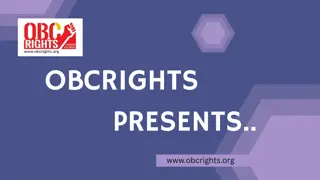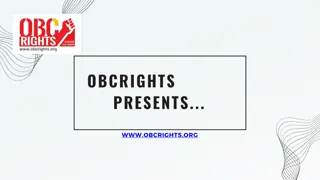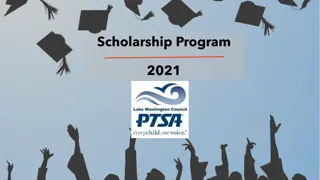Integrating Quality Matters Standards into Scholarship of Teaching and Learning
Explore how Scholarship of Teaching and Learning (SoTL) can be integrated with Quality Matters standards to enhance program development. Discover the journey of creating an interprofessional graduate program and learn how to design SoTL inquiries effectively. Align SoTL with QM standards for curricular analysis and change, and identify key resources for successful implementation. Dive into different types of SoTL projects and understand the importance of aligning QM standards with SoTL inquiry.
Download Presentation

Please find below an Image/Link to download the presentation.
The content on the website is provided AS IS for your information and personal use only. It may not be sold, licensed, or shared on other websites without obtaining consent from the author.If you encounter any issues during the download, it is possible that the publisher has removed the file from their server.
You are allowed to download the files provided on this website for personal or commercial use, subject to the condition that they are used lawfully. All files are the property of their respective owners.
The content on the website is provided AS IS for your information and personal use only. It may not be sold, licensed, or shared on other websites without obtaining consent from the author.
E N D
Presentation Transcript
Quality Matters 8th Annual Conference 2017 SoTL from the Start: Incorporating Quality Matters Standards (Scholarship of Teaching and Learning) Nancy E. Krusen Pacific University
Purpose of the paper The presentation proposes Scholarship of Teaching and Learning (SoTL) intentionally integrated into program development. 2
How did we get here? PhD in Education and Leadership (PhDEL) First interprofessional graduate program Joint-degree College of Education and the College of Health Professions Technology-based, low residency program for the 21st century working professional
Learning Objectives Participants will be able to: 1. Design inquiry across SoTL genres, including confirmatory and exploratory research. 2. Align QM standards with SoTL inquiry to facilitate analysis of curricular design or change. 3. Identify resources for implementation of SoTL from the start projects.
Design inquiry through SoTL What is SoTL? Scholarship of teaching is problem-posting about an issue of teaching or learning, study of the problem through methods appropriate to disciplinary epistemologies, application of results to practice, communication of results, self-reflection, and peer review. Cambridge, B. L. (2001) 5
Design inquiry through SoTL 5 Types of SoTL Group 1: Reports on particular classes Group 2: Reflections on several or many years of teaching experience, informed by other SoTL Group 3: Larger contexts: Comparisons of courses & comparisons of student change across time Group 4: Formal research Group 5: Summaries & analyses of sets of prior studies University of Central Florida Kinds of SoTL Projects http://www.fctl.ucf.edu/researchandscholarship/sotl/whatIsSOTL/kindsofprojects.php 7
Align QM standards w SoTL inquiry Quality Matters General Standards and Rubric: 1. Course Overview and Introduction 2. Learning Objectives (Competencies) 3. Assessment and Measurement 4. Instructional Materials 5. Course Activities & Learner Interaction 6. Course Technology 7. Learner Support 8. Accessibility and Usability 8
Align QM standards w SoTL inquiry GROUP 1. Reports on a particular class Group 1.A. It worked! QM6.1 6.4 Course Technology Q: What is role of technology in supporting PhDEL community? M: LMS materials, live video conference, recordings, eportfolio, university services, GoogleDrive, screencasting, Mendeley O: ID new topics, community of practice smooth start up! Q: How does orientation minimize problems with technology? M: tutorials, participation required, Q & A O: all participants on, tech issues resolved prior to class 9
Align QM standards w SoTL inquiry GROUP 1. Reports on a particular class Group 1.B. Before & after: Qualitative assessments & Group 1.C. Quantitative assessments of changes in practice. QM5.2 & 5.4 Course Activities/Learner Interact Q: How does social presence create a community of scholars? M: discussion forums, Twitter, videoconference, screen casting O: in progress, concerns about attendance for live video, concerns about number of discussion posts 10
Align QM standards w SoTL inquiry GROUP 2. Reflections on several or many years of teaching experience, implicitly or explicitly informed by other scholarship on teaching Group 2. D. Essays developing good ideas. QM5.1 & 5.4 Course Activities/Learner Interact Q: How can modeling use of a journal by instructors support learner professional development? M: assigned journaling, optional prompts, regular shared posts O: in progress, video conference discussion about format, use, purpose 11
Align QM standards w SoTL inquiry GROUP 3: Larger contexts: Comparisons of courses & comparisons of student change across time Group 3. G. Qualitative studies designed to explore a key issue. QM8.1- 8.5 Accessibility & Usability Q: Does the infrastructure support recruitment of diverse learners? retention? engaged student success? meet learner needs? M: tracking learner background, concerns, progress; instructors? O: in progress, how will we grow to suit learners? 12
Align QM standards w SoTL inquiry EXPLORATORY CONFIRMATORY Inductive = Using data to form theory Deductive = Testing theory with data 13
Align QM standards w SoTL inquiry Writing across the curriculum develops scholarship Exploratory/ Inductive Learners write professional journals for each course. Learners identify scholarly interests in journal entries. Interests develop into studies. Writing across the curriculum support development of scholarly research. Confirmatory/ Deductive Theorists propose writing to facilitate scholarship. PhDEL requires journal writing. Observe changes in writing. Confirm research stems from journal writing. 14
Tailor your SoTL inquiry 1. Identify specific scholarly question 2. Describe importance of topic 3. Compose literature review (or annotated bib) 4. Describe the design, data, collection methods 5. Discuss patterns, findings 6. Propose new hypothesis or confirm existing 7. Summarize conclusions, future research 8. Apply, disseminate, invite dialog 15
Tailor your SoTL inquiry QM1.2 Course Overview & Introduction When I use a syllabus quiz will I have fewer emails asking questions about QM2.4 Learning Objectives I added specific learning objectives to each assignment. Will course feedback show that students understand the relationship to the course? QM3.4 Assessment & Measurement Will student competencies for ___ improve when I split the assignment to be both formative and summative? 16
Key messages QM Higher Education rubric can help focus SoTL questions. SoTL questions cross professional boundaries for curricular development. There are a variety of genres of SoTL questions. Bright Eyes Merrihueite Merri
Resources Cambridge, B. L. (2001). Fostering the scholarship of teaching and learning: Communities of practice. In D. Lieberman, & C. Wehlburg (Eds.), To Improve the Academy (pp. 3-16). Bolton, MA: Anker. McDonald, P.L., Lyons, L.B., Straker, H.O., Barnett, J.S., Schlumpf, K.S., Cotton, L., and Corcoran, M.A. (2014). Educational mixology: A pedagogical approach to promoting adoption of technology to support new learning models in health sciences disciplines. Online Learning. 18 (4): 33-50. Nelson, C. E. 2004. Doing It: Selected examples of several of the different genres of SOTL. Journal on Excellence in College Teaching. 14 (2-3), 85-94. 18
Resources Nelson, C. E. 2014. An idealized model for designing, presenting and analyzing SoTL projects. National Teaching and Learning Forum 23(3),1-5. Salmon, V. N. (2004). Practicing Boyer's scholarship of integration: A program for community college faculty - revised. Teaching English In The Two-Year College, 32(1), 64-70. Wilson-Doenges, G., & Gurung, R. R. (2013). Benchmarks for scholarly investigations of teaching and learning. Australian Journal Of Psychology, 65(1), 63-70. 19
Comments? Questions? Nancy E. Krusen, PhD, OTR/L nekrusen@pacificu.edu























